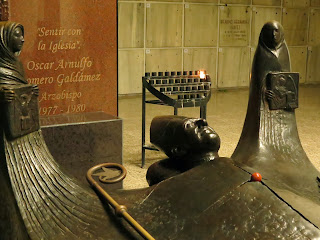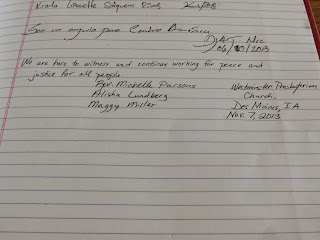Breakfast!!
Alfredo picked us up at 8:00am and we were off for
our sight-seeing around San Salvador. The first place we headed to was the
Memorial Wall in Parque Cuscatlan. The wall is a monument to memory and truth;
a remembrance of all those who were murdered during the Civil War in El
Salvador (officially, 1980-1992). On the wall are the names of 30,000 civilians
who were declared murdered during the Civil War. However, at least 75,000
people were killed during the war (some estimates put the number closer to
300,000). The names of those murdered were listed by year, staring in the 1970s
when tensions were mounting between the government/military and the peasants of
El Salvador. The wall also lists various massacres that occurred around the
country during the war. There were several flowers taped up next to names on
the wall since November 2 was the Day of the Dead.
The Memorial Wall
Mission co-worker Katherine talking about the wall
Names of those killed during the war
Remembering loved ones
Katherine challenged us to pick one name from the
wall to remember. I chose Ada Alicia Guzman.
Maggy and Michelle looking at the wall
Some of the names of people who disappeared
and were probably killed. The year is 1984,
the year I was born.
A rare sighting of a squirrel at the park
Next we went to the National Cathedral where martyr and
Salvadoran Archbishop Oscar Romero was buried. During Romero’s funeral in 1980,
there were too many people at to hold it inside the church. It was held outside
in the nearby park. During the funeral, in an attempt to terrorize people, men (the
Salvadoran army) fired into the crowd from the National Palace nearby. At the
same time cars on the 4 corners around the park exploded. Romero’s body in its
casket was carried hand over hand into the basement of the National Cathedral. The
priests were whisked away into the Cathedral as 7,000 other people crowded in. The
Cathedral is only meant to hold 3,000. While only 40 people died that day the
government had achieved its purpose of terrorizing the people. Many people call
Romero’s death the beginning of the war.
Romero's tomb
Painting of Romero
The National Cathedral
Then we went to Divinia Providencia where Salvadoran Archbishop
Oscar Romero lived and was martyred in 1980. A brief history of Romero: Óscar
Arnulfo Romero y Galdámez was born on August 15, 1917, to Santos Romero and
Guadalupe de Jesus Galdámez in Ciudad Barrios. He was born into a very poor
family in a dirt floor home. At age 13 he began working to pay his way to
seminary in San Miguel but was quickly promoted to seminary in San Salvador and
finished his studies in Rome. On April 4, 1942, Romero was ordained a Catholic priest in Rome. .
On February 23, 1977, he was appointed Archbishop of San
Salvador. His appointment was met with surprise, dismay, and even incredulity.
While this appointment was welcomed by the government, many priests were disappointed,
especially those openly aligning with Marxism. The Marxist priests feared that his
conservative reputation would negatively affect liberation theology's
commitment to the poor.
On March 12, 1977 a
progressive Jesuit priest and personal friend of Romero, Rutilio Grande, who had been creating self-reliance groups among the poor campesinos (country people), was assassinated. His death had a profound
impact on Romero who later stated, “When I looked at Rutilio lying there dead I
thought, ‘If they have killed him for doing what he did, then I too have to
walk the same path’.” In response to Father Rutilio’s murder, Romero revealed a
radicalism that had not been evident earlier. He spoke
out against poverty, social injustice, assassinations, and torture. As a result, Romero began to be noticed
internationally.
On March 23, 1980, the day before his death, he gave a
homily speaking directly to the soldiers. “Brothers, you are from the same
people; you kill your fellow peasants… No soldier is obliged to obey an order
that is contrary to the will of God… In the name of God, in the name of this suffering
people, I ask you, I implore you, I command you in the name of God: stop the
repression!”
Romero was assassinated on March 24, 1980 while celebrating Mass in San Salvador at a small chapel in
Divinia Providencia. He was speaking about a parable just before he was shot:
“Those who surrender to the service of the poor through love of Christ will live
like the grain of wheat that dies… The harvest comes because of the grain that
dies… We know that every effort to improve society, above all when society is
so full of injustice and sin, is an effort that God blesses, that God wants,
that God demands of us.”
Outside the chapel
Collage inside the chapel
The altar where Romero was murdered
A bell outside the church
Out next stop was the University of Central America (the
UCA). On the night of November 16, 1989, a Salvadoran Army patrol entered the
UCA in San Salvador and massacred six Jesuit priests, their housekeeper, and
her daughter. The murders were committed because the Jesuits were voicing
concerns over the atrocities of human rights violations being committed by the
government during the war. They were all taken from their beds in the middle of
the night. Some were killed in their rooms while others were dragged outside
and killed. They were severely beaten before they were murdered.
First we went into the chapel were there are several
sketchings of people, bodies, and torture during the war. People keep these
sketchings nearby because they want to remember the bad things so history does
not repeat itself.
Then we went into the museum at the UCA about the martyrs of
the Civil War. It had information about the Jesuit priests, the housekeeper and
daughter, Romero, his friend Rutilio Grande, the American women and nuns that
were killed, massacre sites, and the thousands of others who were killed during
the war. They had blood spilled from the priests, Romero, and Rutilio Grande, which
I always think is interesting. Salvadorans certainly have a way of preserving
things, even the bad things. They also had clothing the people were wearing
when they died, maps, items that had been burned, and a book that was slashed
by the people who murdered the priests.
Outside of the museum was a rose garden memorializing the
people who were killed at the UCA. It was created by the housekeeper’s husband.
Just around the corner from that was the room where the housekeeper, Elba, and
her daughter, Celina, were killed. Inside one rooms of the UCA are several
photo albums of the victim’s bodies and body parts taken the morning they were
discovered. It’s never easy to look at the photos, but it helps us to better understand
what life was like for ordinary people during the Civil War.
Divinia Providencia
Inside the chapel
Sketches inside the chapel
Inside the UCA museum. There was a lot of
information about poverty in El Salvador
Stories about poverty
Faces of poverty
Children and poverty
Replication of how some people live
A sign about sexual violence against women
Flowers in the garden
The memorial garden at the UCA
Katherine talking about the murders
The message we left in the book:
We are here to witness and continue working
for peace and justice for all people.
Our last stop was for lunch and shopping at the
artisan market. The only photo I took was of my food because, I admit, I got
caught up in the shopping. For lunch I dined on paella, a “hamburger,” and a
tortilla. After shopping for over an hour, we finally started out for Berlin at
2:30pm.
Mmmm lunch!
We arrived in Berlin around 5:00pm. We were warmly greeted
by all the ladies of the Pastoral Team. We got settled in our rooms and again
immediately connected to the internet. Then it was a delicious dinner followed
by a welcome with the Pastoral Team. One of the highlights for me was seeing my
little bird again, Chiquita. Someone gave her to me as a gift in 2011. And she
remembered me! So overall a very happy and very sad day.
Bird kisses!
Chiquita!!




































































2 comments:
Thank you for the Romero stuff. Mostly very accurate (I blog about Romero over at Super Martyrio.)
Visiting Divinia Providencia was one of the most moving experiences of my life, I'm sure it is equally so every time you are there. What an amazing place. So happy you are reunited with Chiquita!
Post a Comment